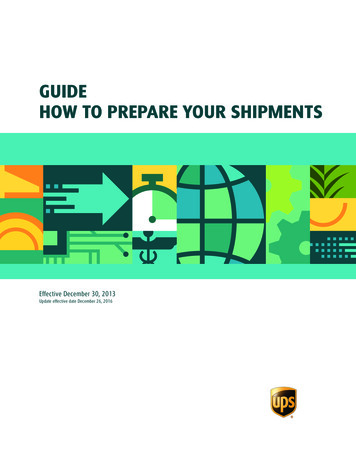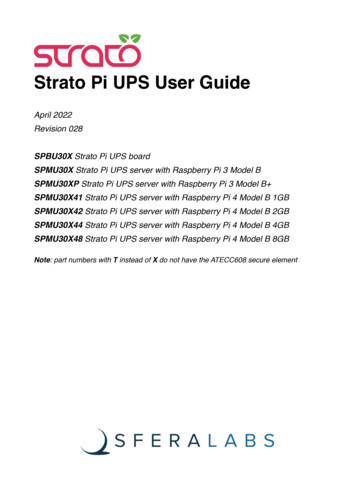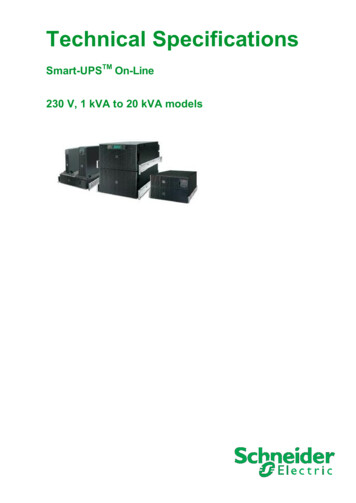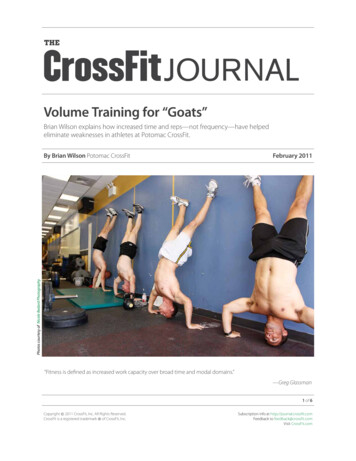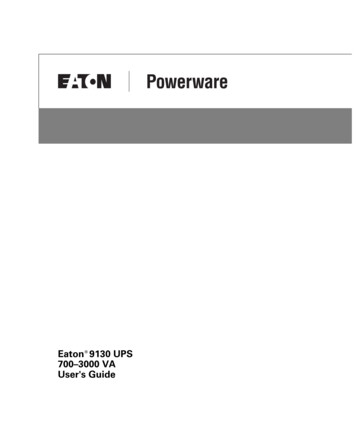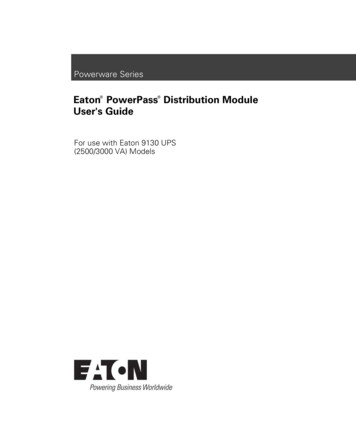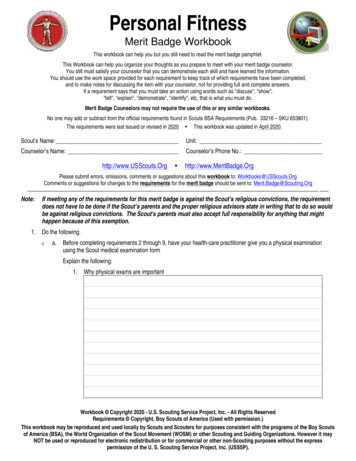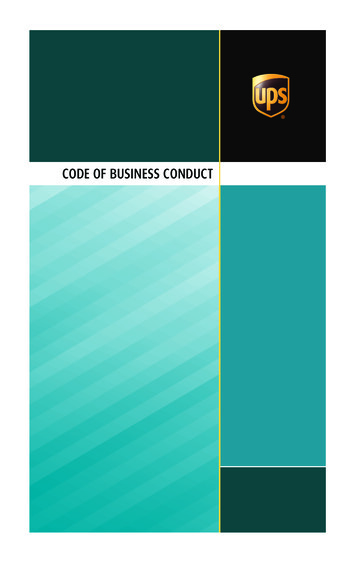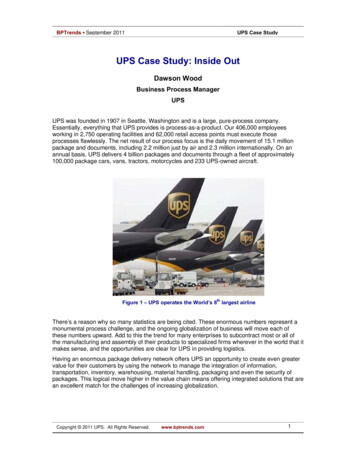
Transcription
BPTrends September 2011UPS Case StudyUPS Case Study: Inside OutDawson WoodBusiness Process ManagerUPSUPS was founded in 1907 in Seattle, Washington and is a large, pure-process company.Essentially, everything that UPS provides is process-as-a-product. Our 406,000 employeesworking in 2,750 operating facilities and 62,000 retail access points must execute thoseprocesses flawlessly. The net result of our process focus is the daily movement of 15.1 millionpackage and documents, including 2.2 million just by air and 2.3 million internationally. On anannual basis, UPS delivers 4 billion packages and documents through a fleet of approximately100,000 package cars, vans, tractors, motorcycles and 233 UPS-owned aircraft.Figure 1 – UPS operates the World’s 8th largest airlineThere’s a reason why so many statistics are being cited. These enormous numbers represent amonumental process challenge, and the ongoing globalization of business will move each ofthese numbers upward. Add to this the trend for many enterprises to subcontract most or all ofthe manufacturing and assembly of their products to specialized firms wherever in the world that itmakes sense, and the opportunities are clear for UPS in providing logistics.Having an enormous package delivery network offers UPS an opportunity to create even greatervalue for their customers by using the network to manage the integration of information,transportation, inventory, warehousing, material handling, packaging and even the security ofpackages. This logical move higher in the value chain means offering integrated solutions that arean excellent match for the challenges of increasing globalization.Copyright 2011 UPS. All Rights Reserved.www.bptrends.com1
BPTrends September 2011UPS Case StudyThe ProblemFor UPS to take advantage of these opportunities, we knew we must move from a primarily USbased, small-package-focused business to a transparent, end-to-end, global operation that canmanage the logistics needs for both small and large enterprises worldwide. Many of the servicesnecessary were available within our network but needed to be globalized. Some would need to becreated. It would have been an easy shortcut to throw money at the problem, but we needed touse our resources wisely. Initiatives that would change UPS needed to be vetted and thenmeasured as they were carried out.Figure 2 – UPS Logistics ServicesThe ApproachUPS has a very strong culture passed down from our founder, Jim Casey, of flexibility, selfevaluation, determination and learning and adaptation. This culture has been tested many timesthroughout the company’s 104 years of existence, but has proved to be the core of why thecompany hasn’t folded to pressure from competitors, challenges from growth, and survival in theworst of economic times. We approached the challenges through several initiatives that wereboth internal to the company and external or market facing.ApproachInside: Create a centralized process group known as the Program Management Group Process Center of Excellence (PMG-PCOE) – So that process can be a differentiator inhow initiatives are proposed, evaluated, approved and measured. We knew that it wascritical to capture our processes and to bring about a new level of maturity towardbusiness process in an organization that already considered process to be its stock intrade.Process Center of Excellence came from an effort that re-defined our StrategicProcesses, which continue to be implemented and refined throughout the organization.PMG-PCOE continues to support the effort to ensure our processes are documented andcurrent and to provide organizational training in process analysis and design.We knew that this group had to be centralized to be effective and that it needed to havevery senior executive support to be broad-reaching enough to make a difference. Byputting program and process in the same hands, we emphasize that we are a processoriented company and acknowledge that projects are the vehicle to implement significantchange(s) to what we do. Since significant change cannot occur without process creationor modification and modifications are managed through projects it seemed a logical stepCopyright 2011 UPS. All Rights Reserved.www.bptrends.com2
BPTrends September 2011UPS Case Studyto combine the Process and Project centers of excellence. We change processes throughprojects in order to meet the needs of our customers.Figure 3 – UPS Program and Process Center of ExcellenceApproachInside: Have the right tools and leverage what we have, where possible. To meet ourneed to capture processes in a straightforward and user-friendly way, we chose theIs/Modeler software. It captures processes as simple activities, provides for activity-basedcosting as an analysis tool, and is very end-user friendly for consumption purposes.When the software’s manufacturer no longer supported the product, we made a decisionto buy the source code so that we would be able to continue with their product. We arestill using Is/Modeler but are evaluating Nimbus’ Control software as its eventualreplacement to put us back on a supported platform with the additional benefits of datacentralization (beyond our current process map library), change management/governance, and role-specific deployment.Copyright 2011 UPS. All Rights Reserved.www.bptrends.com3
BPTrends September 2011UPS Case StudyFigure 4 – UPS process capture exampleProcess management as a methodology hasn’t changed that much from our perspectiveof process being the “what” we do. However, technology and advanced computer deviceshave allowed us to expand our process changes into areas that were otherwise costprohibitive to change in the past. Technology isn’t just about information anymore; it isalso about location, and ultimately it is about improving efficiency that helps reduce ouroperating cost, increases our networks utilization and allows us to stay cost competitive.ApproachInside: Work with APQC and other external organizations – So that we become expertsat benchmarking our processes against others. We have our own operational andsupport process framework known as the Core Process Framework that has been theway to represent process classification at UPS. Meeting the global challenge however,means moving beyond how we see ourselves and being able to drive metrics andscorecards against industry benchmarks. We’re moving toward greater involvement inorganizations like APQC, owner of the Process Classification Framework and arepository of benchmarking data.We are constantly challenging ourselves to improve our processes. One method is tomonitor what others are doing to improve their processes and PMG-PCOE holds acontinual interest in our outside perspective of UPS’ process journey. There is an interestin benchmarking UPS’ process management against what other companies arepracticing; their process journey and the process maturity levels they have obtained.Through our involvement with APQC, we hope to: Validate our approach and methodologyIncrease adoption of the Classification Framework throughout our organizationGain a better understanding of how our process management provides direct,bottom-line impact on the company overallCopyright 2011 UPS. All Rights Reserved.www.bptrends.com4
BPTrends September 2011UPS Case StudyFigure 5 – UPS Core Processes FrameworkApproachOutside: Grow internationally through a combination of geographies (Asia, Cross-borderlogistics expertise, Emerging Markets) and take an aggressive approach. There is muchmore of a global perspective at UPS as we now operate in over 200 countries and use 23languages in our training alone. Just in the way we expanded from our first location inSeattle, Washington, we have now expanded our capabilities/services into Freight,Distribution, Forwarding and Brokerage and into important locations like China. Thesetogether are the backbone of logistics. We need to be where the business is happeningwith the logistics capabilities necessary to carry it out. We are addressing businessprocess internationally as a way of expanding our markets and to support logistics andmanufacturing where it occurs. It is also somewhat of an offensive competitive strategy toleverage our processes and expertise to force competitive responses.Inside: Increasing process focus to meet globalization challenges. Growing internationallymeans risking outsized growth of non-operational costs as the organization strains to dobusiness in new languages, locations and by new rules. Process variations crop upquickly and those variations lead to inefficiency and cost. Being able to grow as quicklyas necessary without losing profitability means having an greater focus on how businessprocess is created, analyzed, communicated and kept up to date both globally and onlywhere necessary, locally.ApproachOutside: To bring the public into our plan to be the leader in logistics, UPS in partnershipwith Ogilvy & Mather created an advertising campaign around our outstanding globallogistics. We made these commercials in Chinese, Spanish, and American and BritishEnglish because this was a truly global launch of the message that we are a powerfullogistics company.Copyright 2011 UPS. All Rights Reserved.www.bptrends.com5
BPTrends September 2011UPS Case StudyFigure 6 – UPS “We love logistics” campaignLogistics is more than moving packages. International logistics involves many potentialobstacles, not the least of which is customs regulations. The obstacles that companiesface when doing international business are significant, and we knew that our workingknowledge of how to move packages has high value to an increasingly global economy.Our message is well received and shows that we have done our homework in: Supply chain managementCustomer service complexityBenchmarking against other logistics operationsThe We Love Logistics campaign has broad process implications – since logisticsindicates an end-to-end process and any of the steps in between as opposed to aproduct-based business. The focus is on management of some portion of our customer’sprocesses or providing them insight into their logistics processes. So the translationrequires new and better integration of our products, multi-modal customer service,integrated planning processes, improved “supply chain” visibility, and service levelprocess improvements across all products and geographies.The ResultsUPS is a truly globalized company that has outgrown the confines of the small-package title thatwe carried for so long. We operate in 200 countries and are using our network in ways that wedidn’t dream of just a decade ago. While we’ve gone through so much change, we fully know thateven more change is coming as more of the world participates in the global economy. These aresome of the specific results we’ve achieved.ResultTo date, we have trained over 700 people worldwide, most recently in Singapore andEurope in the coming months, to author process maps for analysis and processimprovement. A more centralized solution will allow us to store those processes, local orglobal, in a central place for management and communication back out to the resourcesthat need to consume and provide feedback. Centralization also gives us an ability to addsocial capabilities to what we already have through internal systems like UPSers.com.Copyright 2011 UPS. All Rights Reserved.www.bptrends.com6
BPTrends September 2011UPS Case StudyFigure 7 – A recent training business process improvement class in SingaporeBy stressing process as simple communication of activities and their flows, we haveengineered for communication to everyone in the organization and not just processexperts. As an example, we don’t work with swim lanes as a way to show processbecause it defeats our intent of having a simple way to communicate.ResultOur growth in China and other rapidly developing markets demonstrates that ourapproach is working. UPS is now a vital link between many of the world’s technologycompanies and their suppliers and customers.ResultThe profitability of our increasingly international presence is a direct result of both theinternal and external initiatives that we’ve undertaken. To continue on this path we willneed to continue to create process experts and expert process consumers wherever UPShas a presence.ResultFast growth in the medical supply business (heavily regulated) takes advantage of ourprocess focus as we’re expect to comply strictly to: Storage and transport regulationsProduct expiryControlled substances shippingInspectionsWe are currently engaged in the end stages of definition and development of healthcarestandard operating procedures (SOP’s) for controlled and environmentally sensitivegoods, Multi-country legal and regulatory compliance SOP’s and the systems that willallow us to run efficient and reliable processes to meet our customers’ needs whilemaintaining legal and regulatory compliance.Copyright 2011 UPS. All Rights Reserved.www.bptrends.com7
BPTrends September 2011UPS Case StudyFigure 8 – UPS package sortingReferences[1] APQC Frameworks Study: Using Process Frameworks and Reference Models to GetReal Work Done (available for download nimbuspartners.com/apqc)AuthorDawson Wood is the Staff Manager of the Process and Project Centers of Excellence at UnitedParcel Service (UPS). Dawson joined UPS as a package handler in the Northeast Texas Districtin 1982. He was promoted to management in 1985 and held various assignments in Operationsand Industrial Engineering. In 1991 he accepted a special assignment to help manage theDelivery Information Acquisition Device (DIAD) Implementation team.After completing the successful implementation of the DIAD he was assigned to multiple specialassignment teams at corporate between 1995-2000 including UPS TotalTrack, Customer SpecialProjects, In-transit Intercept, and Strategic Process Management - Package. Based on hisextensive experience in project management and process assessment and improvement he wasasked to join the Program Management Group in 2001 as a senior Program manager, the UPSequivalent of a "Black Belt". In 2006 the program, process, and governance roles of PMG werecombined under the UPS Corporate Strategy group and Dawson accepted his current position.Copyright 2011 UPS. All Rights Reserved.www.bptrends.com8
BPTrends September 2011UPS Case StudyDawson has over 20 years' experience in operations management, process improvement, andproject management at UPS. He holds a BS from Auburn University, a Master's degree from theUniversity of Texas, and an MBA from Kennesaw State University in the University System ofGeorgia. When not at work he spends as much time with his family as possible, assists his wifein training canine assistance dogs, and catches as much Braves baseball and Auburn football ashe can.BPTrends Linkedin Discussion GroupWe recently created a BPTrends Discussion Group on Linkedin to allow our members, readersand friends to freely exchange ideas on a wide variety of BPM related topics. We encourage youto initiate a new discussion on this publication or on other BPM related topics of interest to you, orto contribute to existing discussions. Go to Linkedin and join the BPTrends Discussion Group.Copyright 2011 UPS. All Rights Reserved.www.bptrends.com9
Sep 06, 2011 · UPS Case Study: Inside Out Dawson Wood Business Process Manager UPS UPS was founded in 1907 in Seattle, Washington and is a large, pure-process company. Essentially, everything that UPS provides is process-as-a-product. Our 406,000 employees . face when doing international business

